
Ibrahim Mohammadon Sunday
For the first time since 19-07-2012
#Aleppo city is free of terrorism
#Aleppo city is free of terrorism


In December 2016, the Syrian Arab Army, Russia & allies liberated the northern Syrian city of Aleppo of the al-Qaeda and equally-heinous terrorists who had occupied and terrorized civilians in the city since 2012.
In the years subsequent, Aleppo to a large degree returned to peace, with rebuilding occurring in the hard-hit Old City, with displaced Syrians returning (contrary to the lies of UK Channel 4, among other war propagandizing media).
Yet, civilians since that Aleppo’s liberation continued to be terrorized by the presence of terrorists in the countryside of Aleppo.
Last year (January 2019), visiting Aleppo, I returned to the Lairamoun industrial district in the city’s west. I had been there in November 2016, had seen the nightmarish underground prison of the Free Syrian Army, used to hold Syrian soldiers and civilians alike, a true dungeon replete with suffocating solitary confinement cells.
In January 2019, I went to a factory 500 metres from al-Qaeda snipers. Aleppo MP Fares Shehabi explained to me how the factory owner and workers defied the existence of terrorists at close proximity and re-opened the textile factory. As he spoke, he took me to a door which, when opening, exposed us to potential sniper fire–the sniper fire the courageous factory workers were exposed to.

Al-Qaeda stronghold near Lairamoun, Aleppo, 400 to 500 metres from textile factory
Shehabi’s powerful words include:
“This factory is on a front line in the war against terror. 400 to 500 metres away, the Tajik Brigades of the Islamic Turkistan Army, a branch of al-Qaeda in Syria.
This factory was rubble two years ago. We rehabilitated it. We are doing this as a message of defiance against all who conspired against the people of Aleppo, against the economy of Syria. The enemy was sniping at us , launching mortars, when we were fixing this factory to work again.
Show me one place in the world with a production situation like this, a factory being rehabilitated under these circumstances.
This is why they out us under sanctions, this is why they consider us enemies.
How can I be an enemy of freedom and democracy if I want our people to work, to make money, my country to have a production economy, and I don’t yield to al-Qaeda gangs in close proximity to me.
…imagine the difficult situation in which these heroes, the factory workers and owners, had to go through in order to defy al-Nusra and defy Turkey, and rise up again from the ashes. This is a real example of how you rise up, undefeated.”
Eva Karene Bartlettabout 12 months ago
After filming Fares Shehabi / Faris Shihabi speaking powerfully about the courage and resilience of a Lairamoun factory owner and its workers 100s metres from al Qaeda snipers,
[see: https://www.facebook.com/EvaBoBeeva/posts/2344877145522266 ]
[see: https://www.facebook.com/EvaBoBeeva/posts/2344877145522266 ]
Firas Darwish explained some terrorist graffiti left on the outside of the factory: a terrorist sniper nicknamed Abu Mohammed, proud of head shots. …See More


Fares Shehabion Sunday
هكذا كانت #حلب في أسوأ ايامها عام ٢٠١٣..!
عشنا في حصار كامل في كل شيء و فقدنا اكثر من ١١ الف شهيد مدني و ٦٠ الف جريح و لم نستسلم و لم نتخاذل و لم نفقد الامل للحظة لا في أنفسنا و لا في جيشنا و لا في قائدنا..!
اليوم نعيش حلم اصبح حقيقة..نعيش معجزة صنعها هذا الجيش الجبار و الذي لولاه لكنا جميعاً في خبر كان.. …See More





In November 2016 I wrote of the terrorism Aleppo civilians experienced that month and in prior months:
My article on the November 3 terrorist attacks noted:
On the afternoon of Nov. 3, after meeting with Dr. Mohammed Batikh, director of Al-Razi Hospital, the victims of terror attacks which had begun a few hours prior began to arrive one after another, maimed and critically injured. The vehicle bombings and bombardment of Grad missiles, among other attacks, left 18 people dead and more than 200 injured, according to Dr. Zaher Hajo, the head of forensic medicine at Al-Razi Hospital.
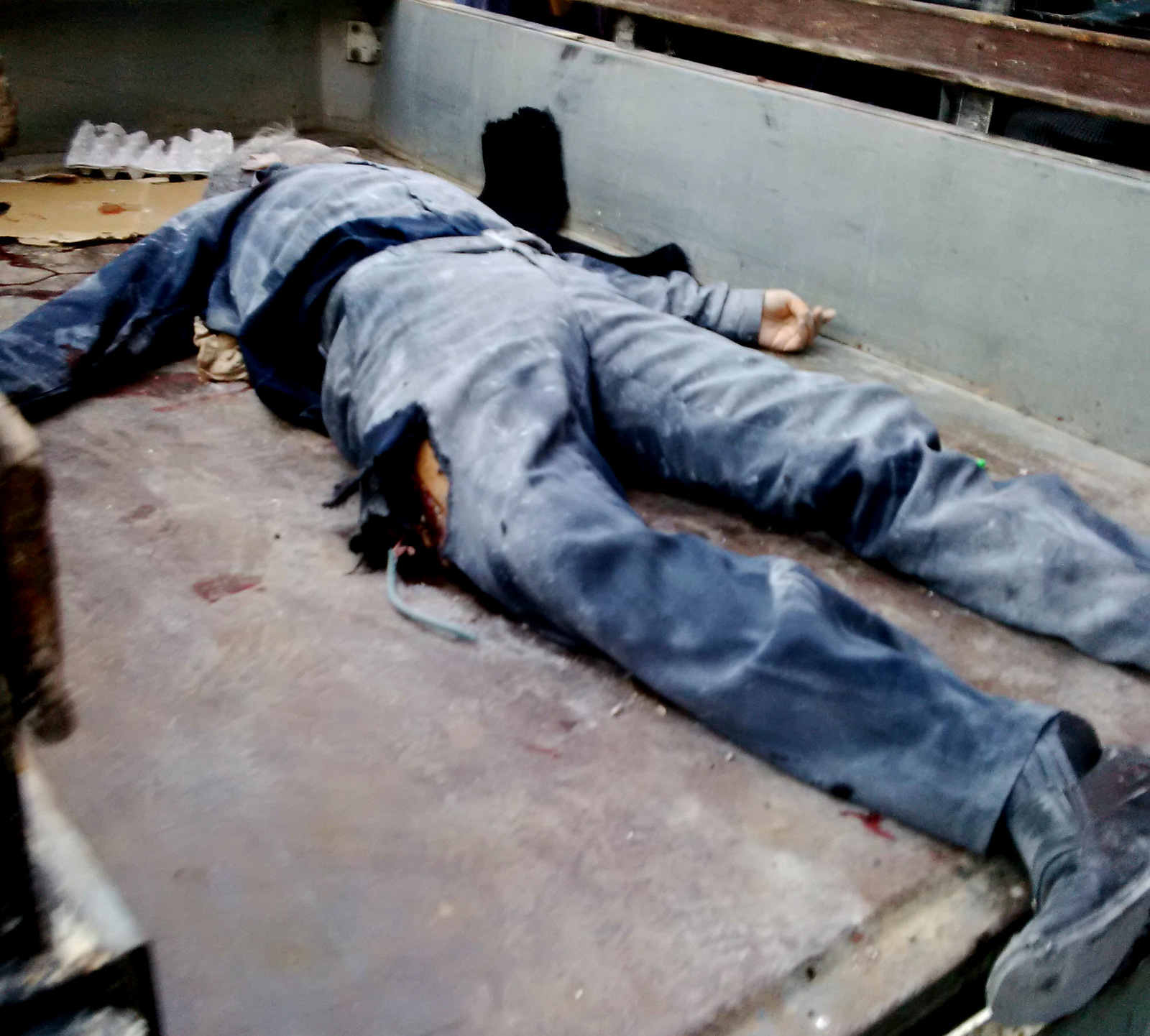
The corridors and emergency ward at Al-Razi Hospital, one of two state-run hospitals in Aleppo, quickly became clogged with the injured and grieving family members. In one crowded interior corridor, one of the wounded screamed out in pain: “Ya, Allah! Ya, Allah!”
In another corridor, a 15-year-old boy with a cast on one leg and bandages on his head, said the mortar attack which injured him had killed his 4-year-old cousin and left his 6-year-old cousin with critical injuries.
In a front room, a mother wailed for her son who had suffered severe injuries. She screamed and pleaded for someone to save him, her only son. Not long after, though, the news came in: the 26-year-old had died. Her son, a doctor, was not the first medical professional to die in terrorists’ routine bombings of Aleppo neighborhoods.

Dr. Nabil Antaki, a gastroenterologist from Aleppo, with whom I met on my trips to Aleppo in July and August, messaged me in October about his friend and colleague, Dr. Omar, who was injured on Oct. 6 when terrorist factions unleashed an attack on Jamiliye Street, killing 10 people. Just a few days after the attack, Dr. Omar, too, died.
At the morgue behind Al-Razi Hospital on Nov. 3, inconsolable family members leaned against the wall or sat on the pavement, coming to grips with the deaths of loved ones.
One 14-year-old boy had been there on Nov. 2, when his father was killed. On Nov. 3, he returned when his mother was killed. Both of this boy’s parents are dead, both killed in terrorist attacks on the city’s New Aleppo district.
A man spoke of a 10-year-old nephew who was shot in the head by a terrorist sniper while the boy was on his roof.
A woman and her children leaned against an iron rail next to the door to the morgue, weeping over the death of her husband, their father, who was killed while parking a car. When the man’s mother arrived, she collapsed, shrieking in grief.
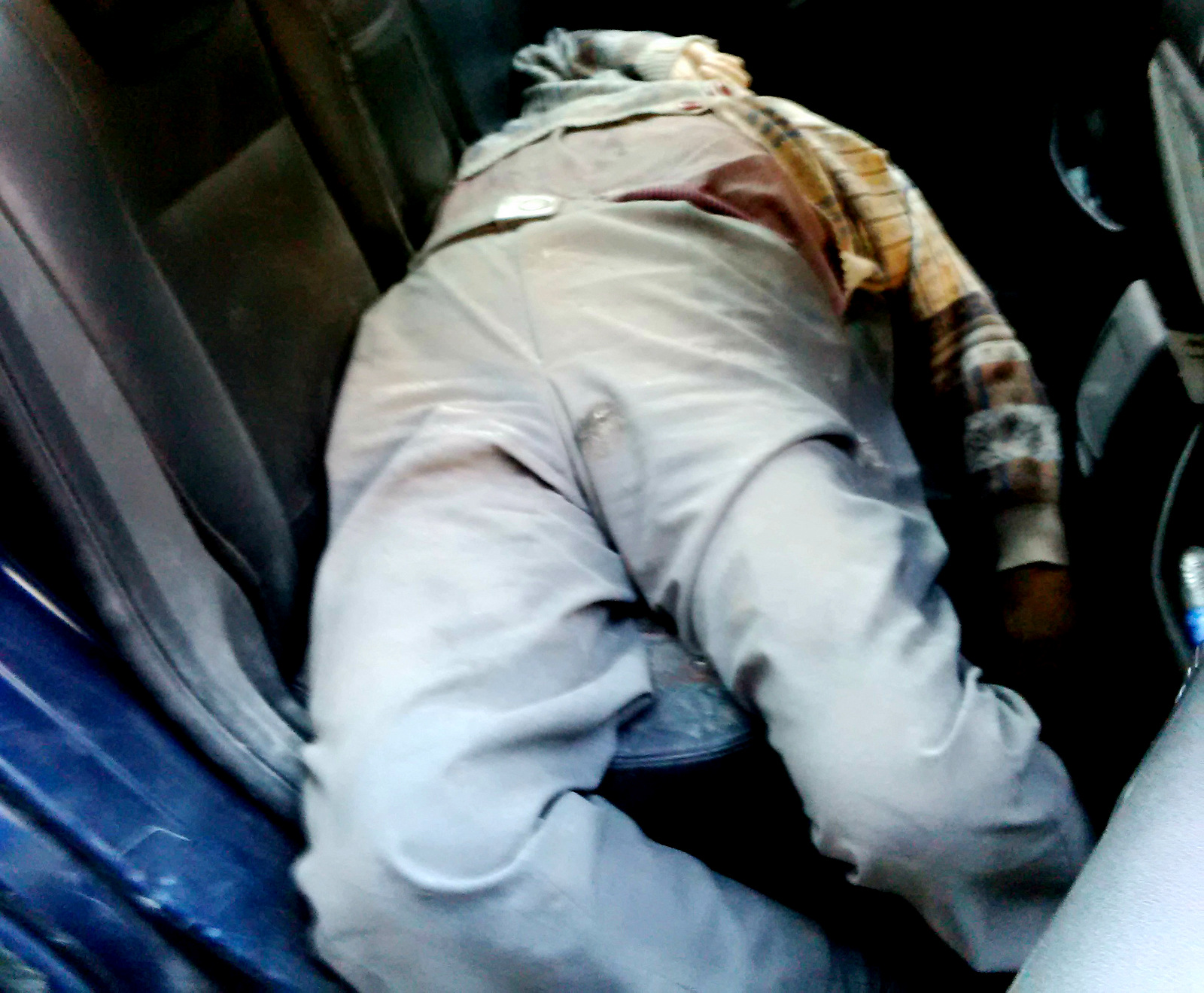
And in the midst of all of this, all these women and children, a car arrived at the morgue with the body of yet another victim of the day’s terror attacks, Mohammed Majd Darwish, 74. His upper body was so bloody that it was unclear whether he had been decapitated.
Near the morgue, Bashir Shehadeh, a man in his forties, said his family had been displaced already from Jisr al-Shughour, a city in Idlib. His mother, some of his friends, and his cousin have been killed by terrorist factions’ shellings. He said enough was enough, and called on the SAA to eliminate the terrorist threat.
Al-Razi’s Dr. Batikh said a private hospital, Al-Rajaa, was hit by a mortar attack. “They cannot do operations now, the operating room is out of service.”
One of the most notable attacks on hospitals was the December 2013 double truck bombing of Al-Kindi Hospital, the largest and best cancer treatment hospital in the Middle East. I have previously reported on other attacks on hospitals in Aleppo, including the May 3 rocket attack which gutted Al-Dabeet, a maternity hospital, killing three women. On Sept. 10, Dr. Antaki messaged me:
Yesterday, a rocket, sent by the terrorists, hit a maternity hospital in Aleppo in Muhafazat Street. Two persons working in the hospital were injured. No death. But the point is that it is a hospital and it was hit by a rocket.”
Dr. Batikh and Dr. Mazen Rahmoun, deputy director of Al-Razi, said the hospital once had 68 ambulances, but now there are only six. The rest, they said, were either stolen by terrorist factions or destroyed.
Aleppo’s doctors continue to treat the daily influx of injured and ill patients in spite of the dearth of ambulances and effects of Western sanctions which mean a lack of medical equipment, replacement parts, and medicine for critical illnesses like cancer.
According to the hospital’s head forensic medicine, Dr. Hajo, in the last five years, 10,750 civilians have been killed in Aleppo, 40 percent of whom were women and children. In the past year alone, 328 children have been killed by terrorist shelling in Aleppo, and 45 children were killed by terrorist snipers.
Humanitarian Crossings: Shelling of Castello Road
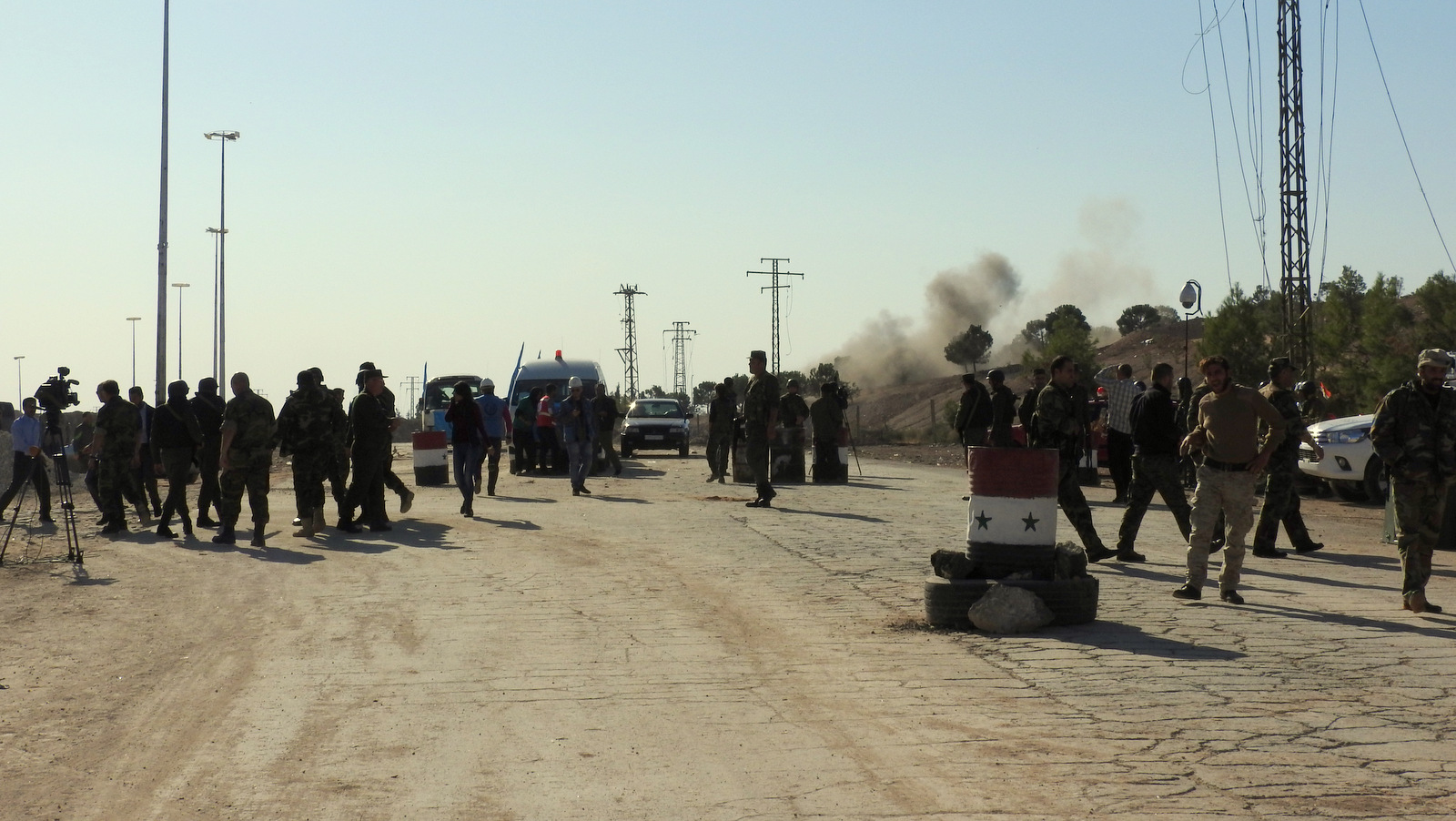
On Nov. 4, prior to our 9:30 a.m. arrival at the Bustan al-Qasr crossing and until our departure an hour later, no one had been able to cross from the area just beyond crossing, which is occupied by Jaysh al-Fatah militants.
Two weeks prior to our arrival, journalists had reported that terrorist factions heavily shelled the crossing and areas around it starting in the early morning.
A Syrian general at the crossing confirmed that shelling had taken place on Oct. 20, adding that three police officers had been wounded. A journalist in the delegation asked the general what he would say to Syrian civilians like Bashir Shehadeh, who demanded that the SAA eliminate the terrorist factions.
“We need to be patient, because the civilians there are not able to leave, they are not guilty,” the general replied. “We don’t work the way that the terrorists work.”
Regarding the amnesty decree issued by President Bashar Assad in late July, the general explained that terrorists who want to be granted amnesty could lay down their arms. Those who choose to go on to Idlib would be granted safe passage by the Syrian government and army, in coordination with the Red Cross and Red Crescent.
According to the general, when two militants arrived at the Bustan al-Qasr crossing about two months ago, they surrendered their arms and proceeded under amnesty.
Five months ago, he said, 12 civilians crossed there, were treated in Aleppo’s hospitals, and returned to their homes in terrorist-held eastern Aleppo.
At the Castello Road humanitarian crossing, the large green buses which were said to be evacuating militants from areas of eastern Aleppo in recent weeks were there again, waiting to ferry away more. Ten ambulances, three buses, and 14 minivans were lined up in anticipation of any civilians or militants trying to leave terrorist-occupied areas, whether for safe passage elsewhere or to settle in government-secured areas of Aleppo.
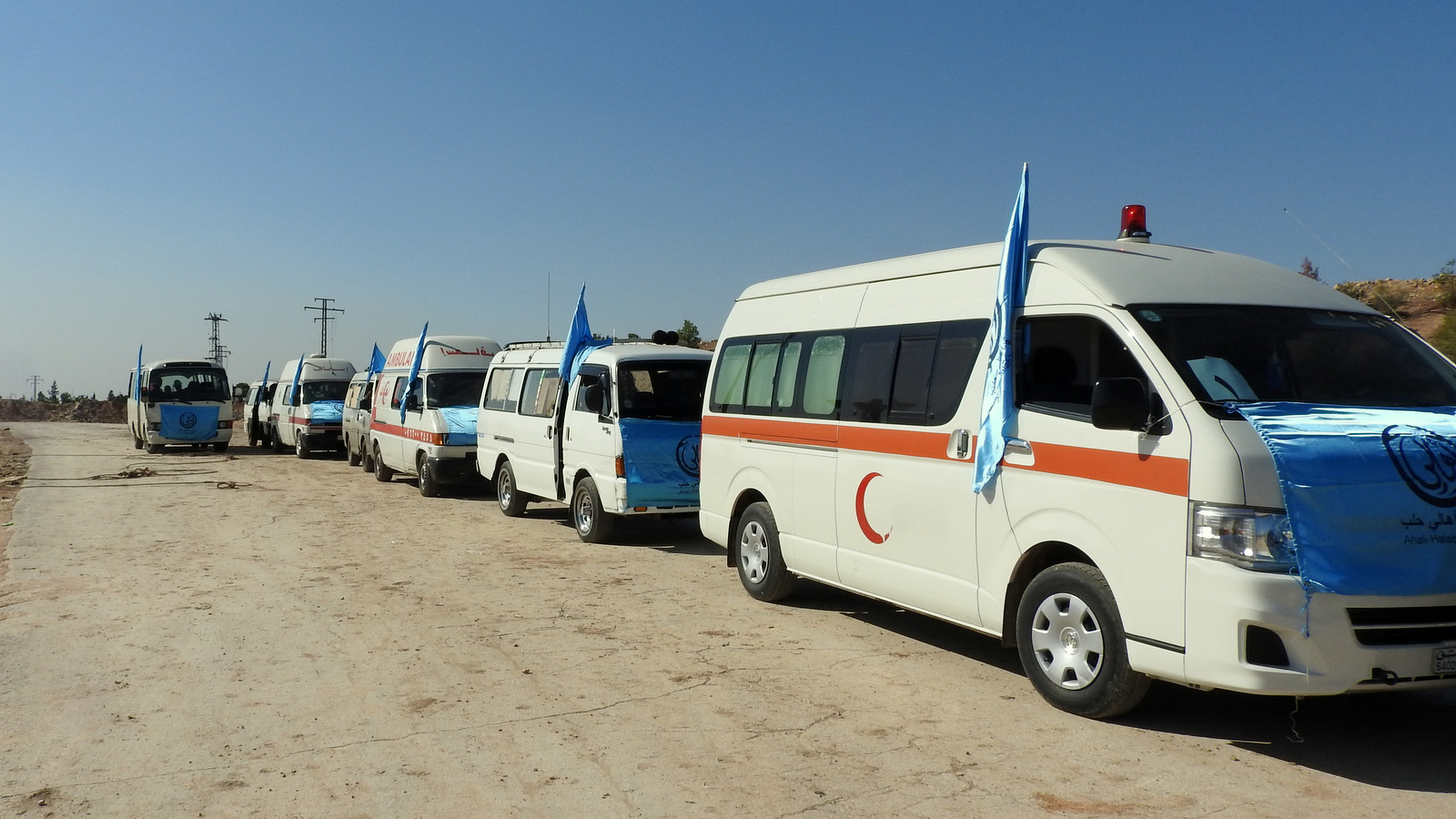
George Sire, 25, an anesthesiologist at Salloum Hospital in Aleppo, was one of the volunteers who arrived at the crossing with five of the private hospital’s ambulances, at the request of the Syrian government.
When speaking with a Syrian commander about permitting men who had used arms against Syrian civilians and soldiers to lay down their arms and reconcile, he said they are sons of the country and urged them to reconcile.
At around 1:30 p.m. the first shell struck, hitting near Castello Road. About 10 minutes later, while I was being interviewed, a second hit, this time considerably closer, within 100 meters — close enough, in fact, to create a cloud of dark smoke over the road. It prompted security to usher me away from the road and move our delegation away from the crossing.
I later learned that another five shells targeted the crossing, injuring a Syrian journalist and two Russian soldiers.
No one passed through this or any of the other seven humanitarian corridors that day.
And:
“Last Friday, I visited one of Aleppo’s main public parks, a once-beautiful park where fountains danced to the songs of Arab greats like Oum Kalthoum, and simple cafes were full.
Now the fountains are dry, the main one littered with rubble from one of many terrorist shellings of the park, and one of the main cafes out of commission after being hit by a terrorist shell roughly a year and a half ago.
While people do continue to frequent the park, the risk of being killed by a mortar or rocket remains, as pretty much everywhere in greater Aleppo.
I had read about the July 22, 2016, terrorist rocket on the park which killed civilians while they were in the park on a summer Friday.
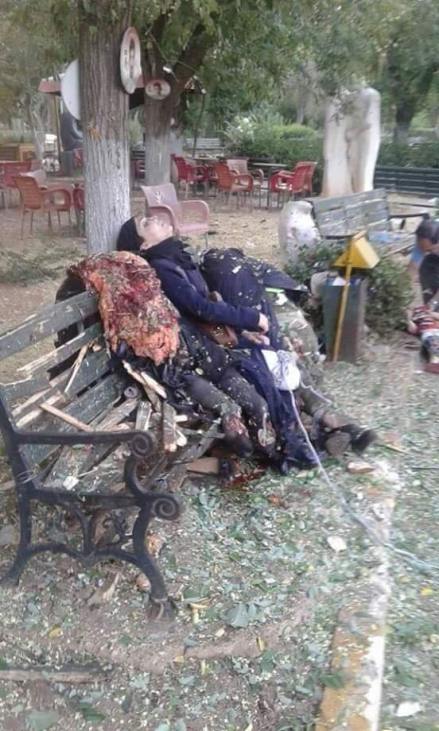
Photo via Pierre Le Corf
SANA news reported on that day that: “Eleven civilians were killed, among them a child and two women, while 44 others were injured in terrorist attacks with rocket shells and sniper bullets on neighborhoods and the public facilities in Aleppo city on Friday.
…eight civilians were killed and 34 others injured in a rocket shell fired by terrorist groups on the public park.”
In November, a local took me to the area where the murdered woman was sitting when the rocket’s shrapnel killed she, another woman, a child, and injured nearby civilians.
The park was busy this Friday, not as busy as a hot summer day would have seen it, but still had people sitting on such benches or on the plastic chairs of the cafe behind where the murdered women had been sitting.
Walking around the large park, we saw evidence of shelling…on the pavement and in the small plots of grass. Some were like the small holes in the pavement that I’m used to seeing in the Old City of Damascus, ravaged by terrorists’ mortars. Others were mini-craters in the grass, including one near a cafe which was hit apparently about a year and a half ago.
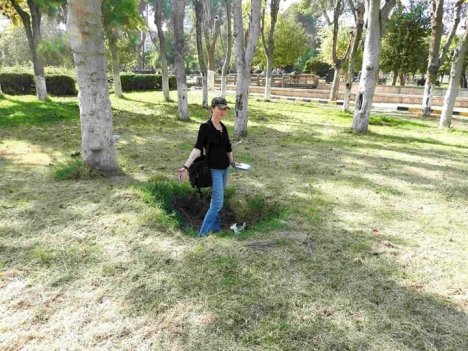
Speaking with local security there, they estimated that between 40-50 shells have hit the park in the past few years. The number could be greater, or less, but the fact is the park has been targeted, as have public places around the city of over 1.5 million people, who on a daily basis facethis mortar/rocket/Grad missile/explosive bullet/gas canister terrorism.
This park in summer would have not only been a spot to try to briefly escape the hell of 6 years of foreign war on Syria, but would also have had many displaced Syrians who have fled terrorist-occupied areas to government-secured areas, many of whom during the day sought refuge in the shade from blistering heat.
Without electricity for years, thanks to the terrorist factions who control the area where the power plant is, Aleppo residents who can afford it buy power by the ampere. Many can only afford the basics–some light bulbs and power for their fridge.
From a photo essay I published in mid-2016, after my second Aleppo visit:
The power plant lies in areas controlled by terrorist factions. For years, Aleppo residents have suffered from a lack of power, and compensate by purchasing generator-supplied electricity. Not cheap, some opt to buy just 1 ampere worth, which according to Aleppo resident Nabil Antaki costs around 4000 Syrian pounds a month (roughly US$8) . Two amperes will run a small television. Four amperes, a fridge, small television and a few bulbs.
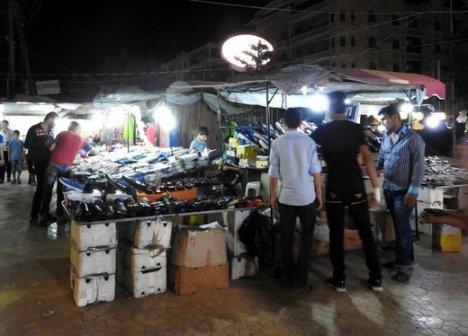
Many others can’t afford that, period. I remember the suffocating heat even on an August visit to Aleppo, staying in a friend’s place without electricity or water…the desire to be out in an open place where one could breathe, sweat less, was strong…
In the canal running through the park, a boy around 14 years old stripped to his underwear and dove in, swept down river by the quick current, scrambling out and up the wall to dive in anew. When we passed the river a little later, a girl had joined in. I asked whether this would be frowned upon and my friend laughed at me, “We are not al-Qaeda here.” (I remembered the words of a man who I’d spoken with the night before, who spoke of al-Nusra in occupied eastern areas forcing women and girls to cover even their wrists and hands. This girl would have no freedom in areas occupied by the West’s “rebels”.)
Scenes like these, of seeming normalcy, can be shattered in an instant, with the fall of a mortar or shell fired by terrorists which the West deems as “moderates” and whose crimes Western leaders continue to ignore.
Eva Karene Bartlettabout 3 years ago
Last Friday, I visited one of Aleppo’s main public parks, a once-beautiful park where fountains danced to the songs of Arab greats like Oum Kalthoum, and simple cafes were full.
Now the fountains are dry, the main one littered with rubble from one of many terrorist shellings of the park, and one of the main cafes out of commission after being hit by a terrorist shell roughly a year and a half ago.
While people do continue to frequent the park, the risk of being killed by a …See More






Small public park in Aziziya. People who are displaced frequent such parks, to get out of the small apartments or government-supplied shelters they live in.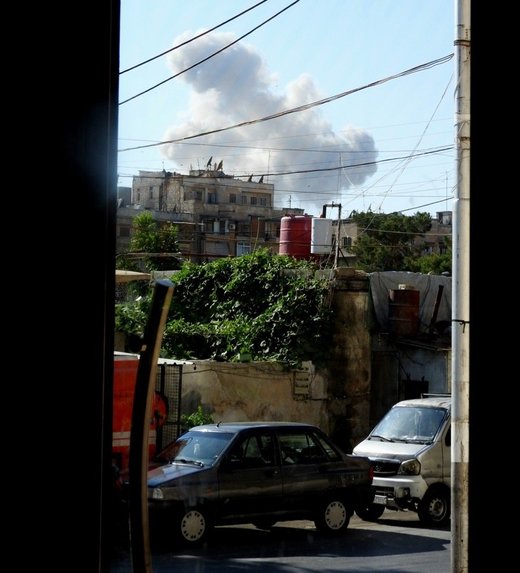

From Aziziya district, on July 4, half a kilometer away, the explosion of a terrorist-fired bomb. Around 5 pm, this is a busy time when streets are packed with cars and pedestrians; terrorists know they can kill and maim more civilians when attacking at these busy hours. Minutes later, an anti-aircraft explosive bullet landed roughly 15 metres away from my Aziziya venue. Had it landed on one of the parked cars, there would have been many casualties. A day later, such an explosive bullet killed the mother of an Aleppo friend, at her home. Photo: Eva Bartlett
In that 2016 photo essay, I wrote also about the villages of Nubl and Zahra’a, north of Aleppo:
Hell Cannon-fired gas canister bombs litter the countryside around Aleppo and on the route to Nubl and Zahra’a. These, and larger variations, are what Western-backed terrorists have rained down on the city of Aleppo, as well as besieged Foua and Kafarya in Idlib governorate. Manufactured locally, fired upon civilians daily, gas canister bombs get virtually no mention in corporate media, although their impact is deadly.

The roughly 65,000 people of Nubl and Zahra’a villages, under siege from terrorist factions of the so-called FSA, al-Nusra, and affiliated factions for three and a half years, were on February 3, 2016, liberated from the choke-hold which strangled them. Zeinab Sharbo, 25, and Mounthaher Khatib, 26, each have young children who suffered for want of food and basic elements of life, and who were traumatized by the terrorists’ bombing of the villages. Although corporate media, when deigning to mention the villages, usually focused on their predominately Shia composition, Sunnis also live in the villages. According to Zeinab, “Sectarianism wasn’t a problem before, we were brothers and sisters, we intermarried with neighbouring villages.”
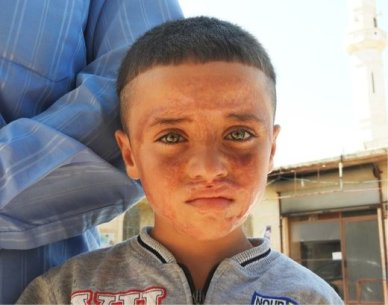
Abdul Karim Assad, 7, has painful face disfiguration from a terrorist-fired mortar which burned his face. Under siege at the time, the boy was only treated with basic medical care in a barebones hospital in Zahra’a. The boy is not originally from Nubl, but from Idlib, from which his grandfather fled when terrorists invaded. He is another poster child for the terrorism inflicted upon Syria.
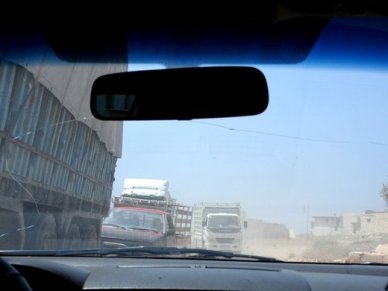
Aleppo’s over 1.5 million residents are depending on trucks from outside of the city to bring in the basics of life. Unable to use the main highway, and now unable to use the paved Ramouseh road, trucks travel an extended distance over many rough dirt roads to enter Aleppo from its north.
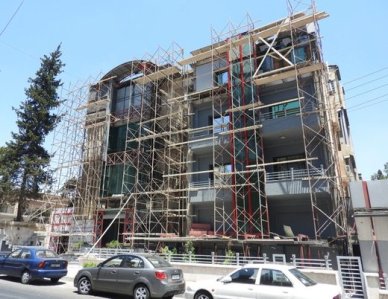
The Dabeet maternity hospital, the inside destroyed and outside badly damaged on May 3, 2016, by terrorist rocket fire, is one of numerous hospitals targeted by terrorists in Syria. The May 3 attack killed three women. A week later, the hospital was hit by terrorist mortar fire. Aleppo’s Kindi hospital, destroyed by terrorists, was one of the largest cancer hospitals in the region.
*
Back to the present.
The Press Office of President Assad on February 17, 2020 published his latest speech, addressing this restoration of peace to Aleppo and the need to do so in Idlib. Syriana Analysis has subtitled this speech:
Partial transcript of recent speech by President Assad:
“When Aleppo city was liberated at the end of 2016, I said that what was before the liberation of Aleppo city will not be the same as what will be after that, and I based that on my knowledge of where the members of our Armed Forces are aiming with their hearts and minds. I based that on my conviction that the patriotism of the people of Aleppo and their fealty to their homeland and the homeland’s army will overturn the calculations of the enemies.
“This is what happened, but Aleppo had to pay a great price equal to the greatness of its people and the patriotism of its position; years of violent and barbaric shelling that affected most neighborhoods, tens of thousands of martyrs, injured people, orphans, people who lost children, and widows. Years of siege without water or electricity or other life necessities, all for Aleppo to kneel and for her people to surrender.
“With every treacherous shell that had fallen, the enemies’ hopes would grow that Aleppo would become another Aleppo, one that never existed throughout history, an Aleppo that does not constitute with its twin Damascus the wings by which the homeland soars; rather an Aleppo whose people would stand with traitors in front of masters, kneeling and prostrating themselves before them, beginning for a few dollars and much disgrace.
“That was in their dreams; but in our real world, with every shell that fell, fear fell and the will to challenge grew. With every martyr, nationalist spirit grew and faith in the homeland became stronger. In our real world, it remained the real Aleppo, the Aleppo of history, nobility, and authenticity. And because it is so, its people did not settle for steadfastness just in the sense of bearing of pain and suffering and acceptance of the status quo; but rather in the sense of work and production that persisted throughout the years of the siege despite the conditions that contradict any economic sense.
“Despite that, this city kept contributing – even if at a bare minimum – to national economy, and I am confident that this type of steadfastness which reflects a concrete will and a deep-rooted sense of belonging is what will raise Aleppo from the ashes of war and restore its natural and leading position in Syria’s economy,” President al-Assad said.
President al-Assad added “It is true that liberating the city in 2016 did not achieve the desired safety for the city at the time, and it remained under the threat of treacherous and cowardly shells, and it is also true today that victory in one battle does not mean victory in the war, but that is by the abstract military logic which is based on endings and results; however, by national logic, victory begins with the beginning of steadfastness even if it was at day one, and by that logic, Aleppo is victorious, and Syria is victorious. We are all victorious over the fear they had tried to instill in our hearts, victorious over the delusions they tried to instill in our minds, victorious over fragmentation, hatred, betrayal, and all those who represent or bear or practice these qualities.
“However, we are fully aware that this liberation does not mean the end of the war, or the failure of schemes, or the disappearance of terrorism, or the surrender of enemies, but it certainly means rubbing their noses in the dirt as a prelude for complete defeat, sooner or later,” the President affirmed.
“It also means that we must not relax; rather we must prepare for the coming battles. Therefore, the battle to liberate the countryside of Aleppo and Idleb will continue regardless of some empty sound bubbles coming from the north, and the battle for liberating all Syrian soil, crushing terrorism, and achieving stability will also continue.”
His Excellency went on to say “Our Syrian Arab Army will never hesitate to carry out its national duties, and it will be as it always has been: an army from the people and for the people. Throughout history, no army has emerged victorious unless the people are united with it in its battle, and when it is united with the people in their vision and cause, and this is what we have witnessed in Aleppo and other Syrian cities, where you embraced the army it protected you, defended you, and made sacrifices for you.
“While we are experiencing times of joy, we must remember that these moments have been made possible by years of pain, heartache, and sadness, for the loss of a dear one that gave their life for the lives and happiness of others. As we bow in honor of the greatness of our martyrs and injured people, it is also our duty to stand in honor of the greatness of their mighty families. If victory is to be dedicated, then it is dedicated to them, and if anyone should receive credit for it, then they deserve the credit. I salute them for the children their raised, and salute their children for their sacrifices. I salute every one of the heroes of our great army and the allied forces begin them. I salute the strength of their bodies in the cold and frost as we bask in warmth and safety.”
President al-Assad went on to salute “our brothers, friends, and allies who stood shoulder to shoulder with the army on the ground and were guardian eagles in the sky, their blood intermingling with the blood of our army that was spilled in Aleppo, Aleppo the faithful to its homeland and history, which will never forget the blood of those who made sacrifices for it, and which will return as it was and stronger.
“Our beloved people in Aleppo, I congratulate you on the victory of your will, the will by which we will wage the greater battle: the battle to build Aleppo. By the will of all the Syrian people we will build Syria, and we will continue liberation, God willing.”
If you haven’t already read it, consider reading my January 2019 compilation:
Eva Karene Bartlett about a year agoTurns Out President Assad Was Right About Terrorism in Syria; Turns Out He Has Massive Popular Support in SyriaIn the workshop of a Sunni Syrian, with his Christmas tree, Imam Ali photo, Quranic calligraphy, and photo of President Bashar al-Assad .See More
because corporate media has been lying to you, not Syria’s president, not Russia.
River to Sea
The views expressed in this article are the sole responsibility of the author and do not necessarily reflect those of the Blog!
No comments:
Post a Comment